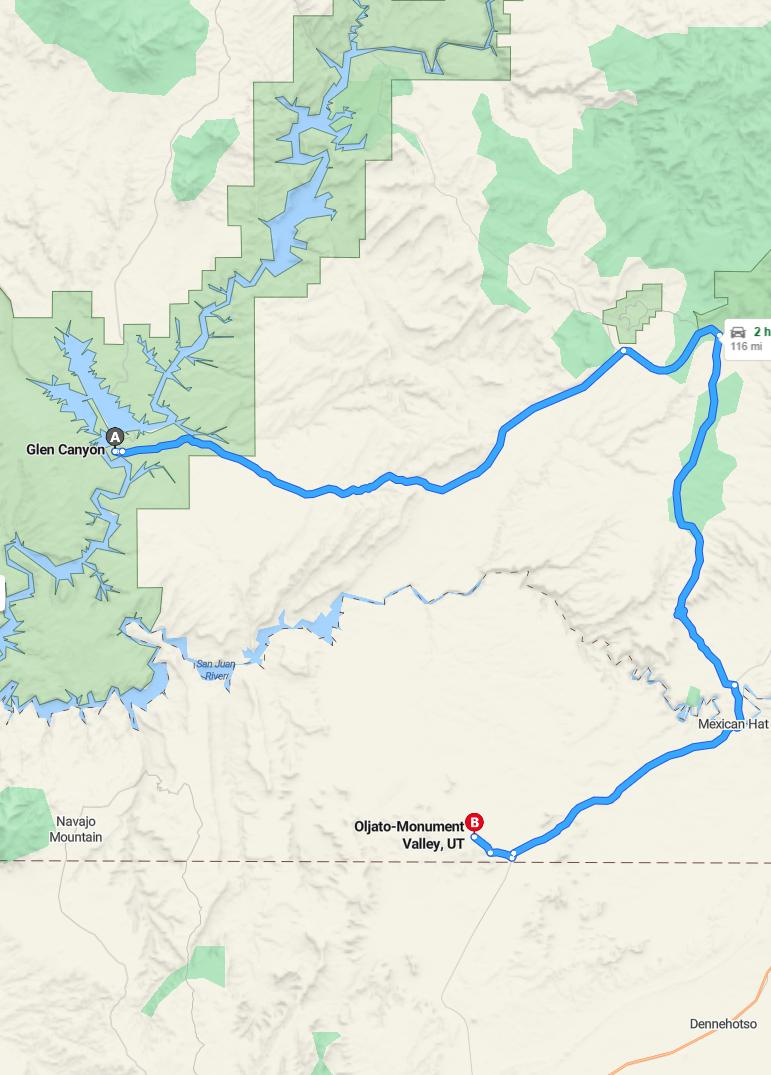Distance and estimated driving time
The scenic drive from Glen Canyon to Monument Valley typically takes approximately 2 hours and 10 minutes, covering about 116 miles. This route primarily follows Utah State Routes 276 and 261, offering travelers breathtaking views of the rugged desert landscape. The journey provides a unique opportunity to experience the natural beauty and geological formations characteristic of this iconic region. Planning ahead for fuel and rest stops can ensure a smooth and enjoyable trip through this stunning part of Utah.
Driving route
Traveling from Glen Canyon to Monument Valley offers a scenic journey through some of the most iconic landscapes in the region. Starting at Glen Canyon, visitors can enjoy breathtaking views and explore the historic Glen Canyon Dam. As you drive towards Mexican Hat, you'll encounter striking rock formations and the charming town named after its famous geological feature. Continuing on, the route takes you through Oljato-Monument Valley, where the spectacular sandstone buttes and mesas create a truly awe-inspiring environment. This trip provides a perfect opportunity to experience the natural beauty and cultural significance of the American Southwest.

Scenic stops and attractions along the way
Traveling from Glen Canyon to Monument Valley offers breathtaking scenic stops and attractions. First, visitors can explore the stunningly colorful Glen Canyon itself, renowned for its dramatic rock formations and incredible canyon views. Continuing to Mexican Hat, travelers are greeted by the iconic rock formation that resembles a sombrero, providing excellent photo opportunities. Finally, Oljato-Monument Valley offers the famous iconic red sandstone buttes and mesas, showcasing the captivating beauty of Navajo tribal lands and making it a must-see destination for scenic vistas and cultural experiences.
Road conditions and driving tips
The drive from Glen Canyon to Monument Valley offers scenic views with generally good road conditions, primarily on paved highways that are well-maintained. Travelers should remain attentive to occasional curves and elevation changes, especially near Mexican Hat and Oljato-Monument Valley, where the terrain can be more rugged. It is advisable to carry sufficient water, fuel, and emergency supplies, as services may be sparse along the route. Additionally, driving during daylight hours is recommended for optimal visibility and safety, especially in regions with limited cell service and fewer landmarks.
Best time to visit for optimal weather
The best time to visit Glen Canyon, Mexican Hat, and Monument Valley for optimal weather is during the spring months of April and May or the fall months of September and October. During these periods, temperatures are generally mild and comfortable, making outdoor exploration enjoyable without the extreme heat of summer or the cold of winter. Spring and fall also tend to have lower chances of rainfall, providing clearer skies for sightseeing and photography. Visiting during these seasons enhances your experience by offering pleasant weather, comfortable conditions, and stunning scenic vistas.
Local landmarks and points of interest
Traveling from Glen Canyon to Monument Valley offers a scenic journey through some of the region's most iconic landmarks. Starting at Glen Canyon, visitors can marvel at the breathtaking canyon formations and the renowned Lake Powell. Continuing through Mexican Hat, named for its distinctive rock formation resembling a sombrero, travelers experience unique geological features. Finally, reaching Oljato-Monument Valley, visitors are treated to the stunning red sandstone buttes and mesas that have become symbols of the American Southwest and cinematic history.
Recommended travel gear and supplies
When traveling from Glen Canyon to Monument Valley, it's essential to be well-prepared with the right gear and supplies. Bring a sturdy, all-terrain vehicle or a reliable downcast vehicle suited for rugged roads, along with a GPS device or detailed maps for navigation through remote areas like Mexican Hat and Oljato. Pack plenty of water, snacks, and emergency medical supplies to stay hydrated and healthy during your journey. Additionally, include sun protection such as hats, sunscreen, and sunglasses, along with extra clothing layers to accommodate changing weather conditions in the desert landscape.
Nearby lodging options and accommodations
Travelers driving from Glen Canyon to Monument Valley can find a variety of nearby lodging options to suit different preferences. In the vicinity of Mexican Hat, guests can choose from cozy motels and inns offering comfortable, affordable accommodations with scenic views. Near Oljato-Monument Valley, visitors have access to renowned park lodges and luxury resorts that provide convenient proximity and stunning desert landscapes. Whether seeking rustic charm or upscale comfort, travelers can select from a range of hotels and lodges to enhance their southwestern adventure.
Safety precautions for desert driving
When driving through desert regions such as Glen Canyon, Mexican Hat, and Monument Valley, it is essential to prioritize safety to ensure a smooth journey. Always carry ample water, extra fuel, and emergency supplies, as services may be sparse in remote areas. Ensure your vehicle is in good condition, with tires properly inflated and brakes functioning well, to handle rough and unpaved roads. Additionally, check the weather forecast before setting out, avoid driving during extreme heat or storms, and inform someone about your travel plans for added safety.
Cultural and historical significance of the area
The area between Glen Canyon and Monument Valley is rich in cultural and historical significance, especially for Native American communities such as the Navajo Nation. Glen Canyon once played a vital role in indigenous history before the construction of the dam, which transformed the landscape and water management in the region. Mexican Hat, a well-known geological formation, holds cultural importance as a natural landmark that has been referenced in local legends and stories. Monument Valley is internationally recognized as an iconic symbol of Navajo culture and history, featuring towering sandstone buttes that have been featured in countless films and photographs, reflecting the deep spiritual and cultural connection of the Navajo people to their land.
